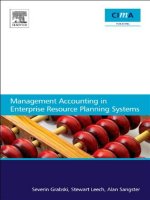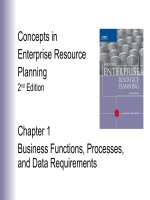Concepts in enterprise resource planning 4th business functions business processes ch01
Bạn đang xem bản rút gọn của tài liệu. Xem và tải ngay bản đầy đủ của tài liệu tại đây (272.82 KB, 45 trang )
About the Presentations
• The presentations cover the objectives found in the
opening of each chapter.
• All chapter objectives are listed in the beginning of
each presentation.
• You may customize the presentations to fit your
class needs.
• Some figures from the chapters are included. A
complete set of images from the book can be found
on the Instructor Resources disc.
1
Concepts in Enterprise
Resource Planning
Fourth Edition
Chapter One
Business Functions and Business
Processes
Objectives
After completing this chapter, you will be able to:
• Name the main functional areas of operation used in
business
• Differentiate between a business process and a business
function
• Identify the kinds of data each main functional area
produces
• Identify the kinds of data each main functional area needs
• Define integrated information systems, and explain why
they are essential in today’s globally competitive business
environment
Concepts in Enterprise Resource Planning, Fourth Edition
3
Introduction
• Enterprise Resource Planning (ERP) programs:
Core software used by companies to coordinate
information in every area of business
– Help manage companywide business processes
– Use common database and shared management
reporting tools
• Business process: Collection of activities that
takes some input and creates an output that is of
value to the customer
Concepts in Enterprise Resource Planning, Fourth Edition
4
Functional Areas and Business
Processes
• To understand ERP, you must understand how a
business works
– Functional areas of operation
– Business processes
Concepts in Enterprise Resource Planning, Fourth Edition
5
Functional Areas of Operation
•
•
•
•
•
Marketing and Sales (M/S)
Supply Chain Management (SCM)
Accounting and Finance (A/F)
Human Resources (HR)
Business functions: Activities specific to a
functional area of operation
Concepts in Enterprise Resource Planning, Fourth Edition
6
Functional Areas of Operation (cont’d.)
Figure 1-1 Examples of functional areas of operation and their business functions
Concepts in Enterprise Resource Planning, Fourth Edition
7
Functional Areas of Operation (cont’d.)
• Functional areas are interdependent
– Each requires data from the others
• Better integration of functional areas leads to
improvements in communication, workflow, and
success of company
• Information system (IS): Computers, people,
procedures, and software that store, organize, and
deliver information
Concepts in Enterprise Resource Planning, Fourth Edition
8
Business Processes
• Collection of activities that takes one or more kinds
of input and creates an output that is of value to
customer
– Customer can be traditional external customer or
internal customer
• Thinking in terms of business processes helps
managers to look at their organization from the
customer’s perspective
Concepts in Enterprise Resource Planning, Fourth Edition
9
Business Processes (cont’d.)
Figure 1-2 Sample business processes related to the sale of a
personal smartphone
Concepts in Enterprise Resource Planning, Fourth Edition
10
Business Processes (cont’d.)
• Businesses must always consider customer’s
viewpoint in any transaction
• Successful customer interaction
– Customer (either internal or external) is not required
to interact with each business function involved in
the process
• Successful business managers view business
operations from the perspective of a satisfied
customer
Concepts in Enterprise Resource Planning, Fourth Edition
11
Business Processes (cont’d.)
• Sharing data effectively and efficiently between and
within functional areas leads to more efficient
business processes
• Integrated information systems: Systems in
which functional areas share data
Concepts in Enterprise Resource Planning, Fourth Edition
12
Business Processes (cont’d.)
Figure 1-3 A process view of business
Concepts in Enterprise Resource Planning, Fourth Edition
13
Business Processes (cont’d.)
• Businesses take inputs (resources) and transform
these inputs into goods and services for customers
– Inputs: Material, people, equipment
• Managing inputs and business processes
effectively requires accurate and up-to-date
information
Concepts in Enterprise Resource Planning, Fourth Edition
14
Functional Areas and Business
Processes of a Very Small Business
• Example: A fictitious coffee shop
– Examine business processes of the coffee shop
– See why coordination of functional areas helps
achieve efficient and effective business processes
– Look at how integration of the information system
improves the business
Concepts in Enterprise Resource Planning, Fourth Edition
15
Marketing and Sales
• Functions of Marketing and Sales
–
–
–
–
–
Developing products
Determining pricing
Promoting products to customers
Taking customers’ orders
Helping create a sales forecast
Concepts in Enterprise Resource Planning, Fourth Edition
16
Marketing and Sales (cont’d.)
• Marketing and Sales tasks for the coffee shop
–
–
–
–
Formal recordkeeping not required
Need to keep track of customers
Product development can be done informally
Good repeat customers allowed to charge purchases
—up to a point
• Records must show how much each customer owes
and his or her available credit
Concepts in Enterprise Resource Planning, Fourth Edition
17
Supply Chain Management
• Functions within Supply Chain Management
– Making the coffee (manufacturing/production)
– Buying raw materials (purchasing)
• Production planning requires sales forecasts from
M/S functional area
– Sales forecasts: Analyses that attempt to predict
the future sales of a product
Concepts in Enterprise Resource Planning, Fourth Edition
18
Supply Chain Management (cont’d.)
• Production plans used to develop requirements for
raw materials and packaging
– Raw materials: Bottled spring water, fresh lemons,
artificial sweetener, raw sugar
– Packaging: Cups, straws, napkins
• SCM and M/S must choose a recipe for each
coffee product sold
Concepts in Enterprise Resource Planning, Fourth Edition
19
Accounting and Finance
• Functions within Accounting and Finance
– Recording raw data about transactions (including
sales), raw material purchases, payroll, and receipt
of cash from customers
• Raw data: Numbers collected from sales,
manufacturing and other operations, without any
manipulation, calculation, or arrangement for
presentation
Concepts in Enterprise Resource Planning, Fourth Edition
20
Accounting and Finance (cont’d.)
• Data from Accounting and Finance used by
Marketing and Sales and Supply Chain
Management
– Sales records are important component of sales
forecast
– Sales forecast is used in making staffing decisions
and in production planning
– Records from accounts receivable used to monitor
the overall credit-granting policy of the coffee shop
Concepts in Enterprise Resource Planning, Fourth Edition
21
Human Resources
• Functions of Human Resources
– Recruit, train, evaluate, and compensate employees
• HR uses sales forecasts developed by the
individual departments to plan personnel needs
• Systems integrated using ERP software provide
the data sharing necessary between functional
areas
Concepts in Enterprise Resource Planning, Fourth Edition
22
Functional Area Information Systems
• Potential inputs and outputs for each functional
area described next
• Note the kinds of data needed by each area and
how people use the data
• Information systems maintain relationships
between all functional areas and processes
Concepts in Enterprise Resource Planning, Fourth Edition
23
Marketing and Sales
• Needs information from all other functional areas
• Customers communicate orders to M/S in person
or by telephone, e-mail, fax, the Web, etc.
• M/S has a role in determining product prices
– Pricing might be determined based on a product’s
unit cost, plus some percentage markup
– Requires information from Accounting and Finance,
and Supply Chain Management data
Concepts in Enterprise Resource Planning, Fourth Edition
24
Marketing and Sales (cont’d.)
Figure 1-4 The Marketing and Sales functional area exchanges data with
customers and with the Human Resources, Accounting and Finance, and
Supply Chain Management functional areas
Concepts in Enterprise Resource Planning, Fourth Edition
25









